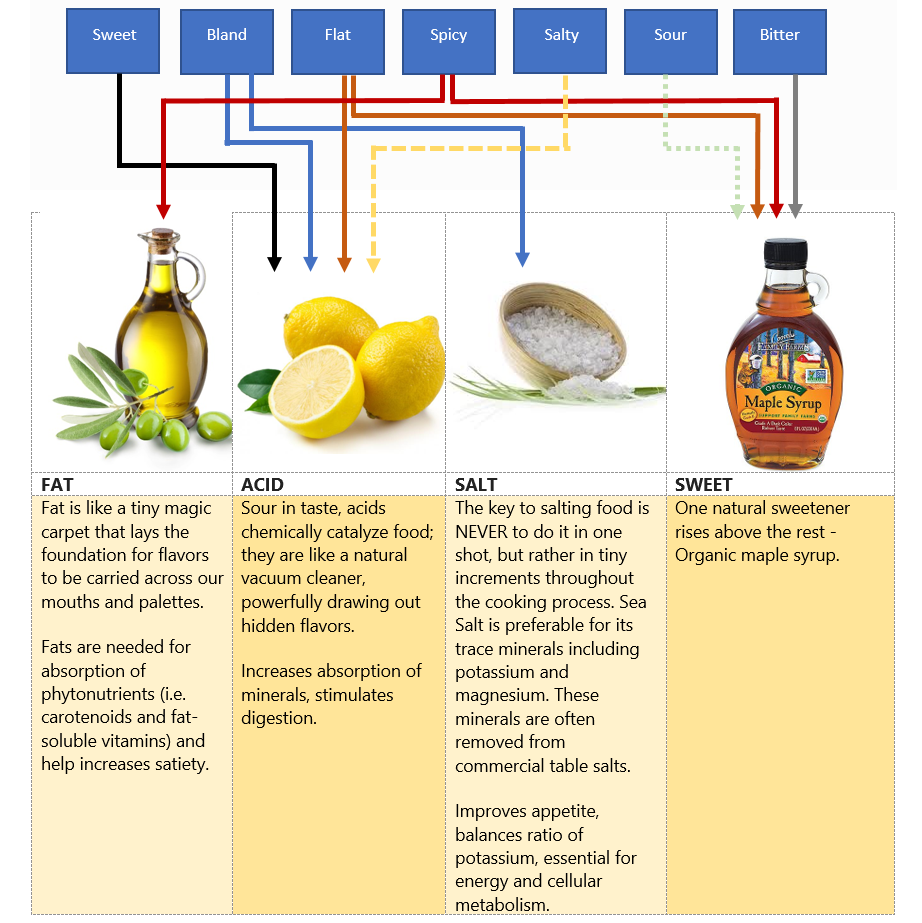Enhancing Flavors and Training Your Taste Buds
When trying to eat healthy, one often hears complaints is that the food tastes bland or boring. Using Fat, Acid, Salt, and Sweet, or FASS for short (a term coined by Rebecca Katz in her cook books), is a simple technique that can really help enhance and correct flavors. In our kitchen, the fat is olive oil, lemons are the acid, sea salt is the salt, and maple syrup is our preferred sweet.
FASS is a culinary tool to help any dish whose flavor has strayed off course during the cooking process, and to bring food to the table bursting with flavor. That’s an absolute must for someone dealing with subpar taste buds – great to help with desensitized taste buds or for people undergoing or detoxing from treatments such as chemotherapy or radiation therapy. Acid and salt add high notes to taste, each in its own way; fat and sweet tend to bring roundness and fullness to a dish. FASS is just an acronym to remind you of these fundamentals, which chefs and many cooks do by intuition much of the time.
Here’s how Rebecca explains FASS in action:
“When I make a soup, I taste it throughout the cooking process. It’s a good habit to adopt, a fun way to fix in your memory what each new ingredient brings to the table. Also, constant tasting is the only way to ensure that a dish has optimum flavor without running the risk of having to resort to drastic measures after it’s completed. By adding a spritz of lemon here or a pinch of salt there, you can better alchemize the ingredients so that what hits the tongue in the end is pure bliss.
I conduct workshops on to how to use FASS. I usually cook up a batch of carrot-ginger soup, which unbeknownst to the participants has been watered down just enough to throw off the taste. Still, the bright orange color looks just about right, and a hint of the smell is also there. They line up to taste the soup, anticipation in their eyes, but upon taking a sip they look disappointed, to say the least.
Now that I have their attention, I explain the role that FASS plays for taste. I start with sea salt, as it has more than eighty minerals and a much fuller flavor than normal table salt. Sea salt stimulates nerve endings and ignites taste. By contrast, lemons, citrus in general, and other acidic ingredients are like turning up the treble and brighten up whatever tastes you’ve brought out with the salt. Sweet— in this case maple syrup— adds a depth or roundness to flavor that’s the equivalent of hearing an orchestra in a concert hall, rather than on your stereo. Just a bit of sweetness can transform a two-dimensional taste encounter into a memorable 3-D culinary experience. As for fat, it serves as a chauffeur supreme, transporting the salt, sweet, and acidic tastes to the different islands of taste buds throughout the mouth, guaranteeing that all the buds— impaired and healthy— have an opportunity to at least listen to the concert.
Once people understand the FASS components, and the role they play, the application of FASS is a pure delight to watch. That meh carrot-ginger soup turns into something that tastes fantastic in just a few minutes. Even people with no cooking experience have an innate sense of how something should taste, and can usually point to the right FASS ingredient and say, “How about we add a little of this?” The soup quickly comes back into balance with each touch of FASS, getting closer to that culinary ambrosia we are looking for. FASS makes a good meal great. For those with more challenging taste issues, it can spell the difference between finding meals palatable, which keeps the appetite engaged, and losing interest in eating healthy. FASS works wonders. Use it, and enjoy!”
If it is Too…? Add a drop or a pinch of

